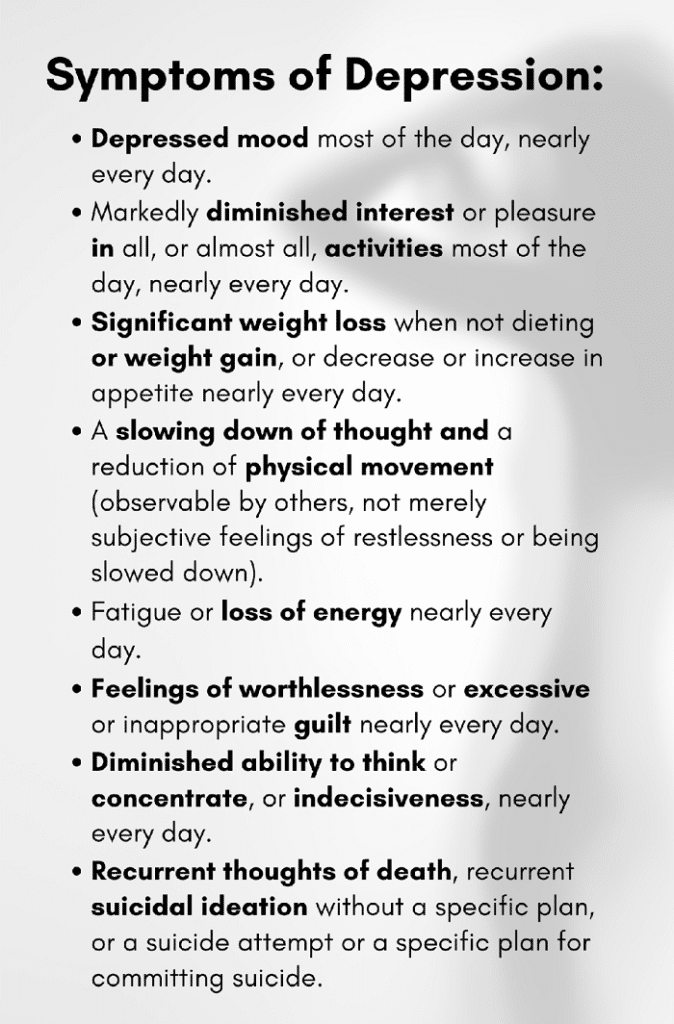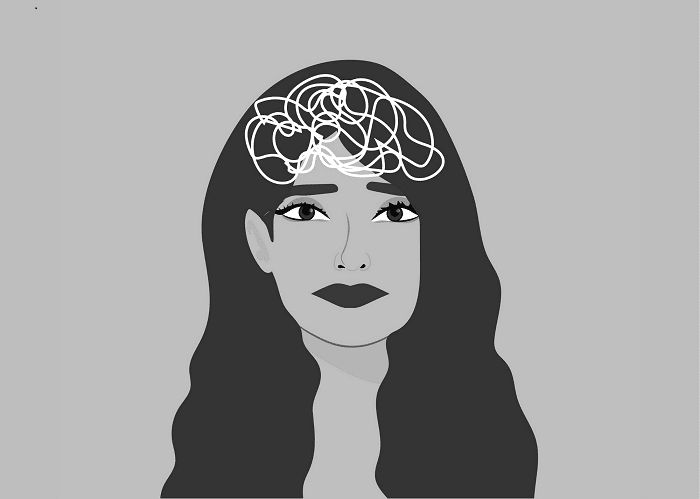“A human being can survive almost anything as long as she sees the end in sight. But depression is so insidious, and it compounds daily, that it’s impossible to ever see the end.” – Elizabeth Wurtzel
What’s depression? It’s a complex illness categorized as a mood disorder. And everything from nerve cell connections to the brain’s physical anatomy play a hand in it.
Symptoms of Depression
Depression is bigger than just feeling blue. To be diagnosed with it, five or more of the following criteria must be met for two consecutive weeks, with symptoms of depressed mood or loss of interest or pleasure in activities present.

People experiencing depression may also present with irritability, obsessive rumination, anxiety, phobias, excessive worry over physical health, and complaints of pain.
Depression is Common
A snapshot of U.S. Census Bureau data in February 2022 showed that nearly one-third of Americans struggled with at least one of the symptoms of depression. And when it comes to youth, the number is even more staggering.
In September 2021, info released by OPI revealed that 41% of Montana high school students reported feelings of sadness or hopelessness for two or more consecutive weeks—a hallmark symptom of the disorder.
Depression Myths
Below are a few common myths about depression that lead to stigma and prevent people from seeking treatment.
Depression isn’t a real illness.
It’s a common misconception that depression is simply sadness or a weakness in character. On the contrary, it’s a neurological condition deeply intertwined with physical health, manifesting as pain and correlating with cardiovascular and inflammatory diseases.
Depression is always triggered by adversity or life transitions.
Yes, adverse events and life changes can trigger a depressive episode. But around sixteen million adults are diagnosed with depression every year, independent of those factors.
And for those individuals, disruptions in neurotransmitters playing key roles in mood regulation are thought to be linked to illness.
Neurotransmitter imbalances connected to depression include:
Dopamine: Helps regulate emotion, memory, thinking, motivation, and reward
Norepinephrine: Makes your heart rate and blood pressure soar during a “fight or flight” response or stressful time
Serotonin: Helps regulate mood and plays a role in your overall sense of well-being; known as the “feel-good” chemical
Researchers continue to study the causes of imbalances, and neurotransmitters acetylcholine, GABA, and glutamate are also thought to be linked to the disorder.
Depression is a sign of weakness.
Depression affects people from all walks of life, indiscriminate of age, gender, race, education, or social class. And it’s more than mindset. There are clear differences in the structure and chemistry of the brain in people with the condition.
Learn more: How Depression Affects The Brain – Yale Medicine Explains
You’d know if someone was struggling with depression.
Symptoms of depression may not be straightforward to others. Many people who suffer go to work or school and seem more irritable or anxious than sad.
The key is to look for significant changes, such as becoming more argumentative, hopeless, or less social. Shifts in weight or eating habits can also be a good indicator of the disorder.
Special Note:
Depression is associated with a high mortality rate due to suicide. So, it’s critical to know the warning signs of crisis and how to get someone help if they’re struggling.
Below is an exert from the National Institute of Mental Health’s website on behaviors associated with heightened risk for suicide and resources to help.
Warning Signs of Suicide
The behaviors listed below may be some of the signs that someone is thinking about suicide.
Talking about:
- Wanting to die
- Great guilt or shame
- Being a burden to others
Feeling:
- Empty, hopeless, trapped, or having no reason to live
- Extremely sad, more anxious, agitated, or full of rage
- Unbearable emotional or physical pain
Changing behavior, such as:
- Making a plan or researching ways to die
- Withdrawing from friends, saying goodbye, giving away important items, or making a will
- Taking dangerous risks such as driving extremely fast
- Displaying extreme mood swings
- Eating or sleeping more or less
- Using drugs or alcohol more often
If these warning signs apply to you or someone you know, get help as soon as possible, particularly if the behavior is new or has increased recently.
National Suicide Prevention Lifeline
Dial 988 or 1-800-273-TALK for free 24/7, confidential support.
Crisis Text Line
Text “HELLO” to 741741
Want to learn more?
Check out the depression section of our blog, and stay tuned to our social media channels for more mental health tidbits. You can find us on LinkedIn at Youth Dynamics of Montana, Instagram at youthdynamicsmt, and Facebook at Youth Dynamics of Montana & People of Youth Dynamics.



